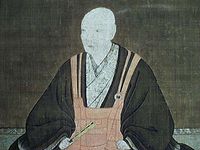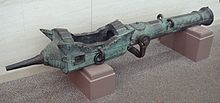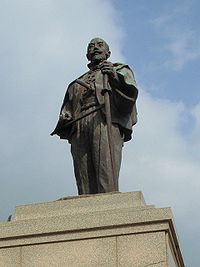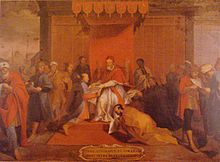- Ōtomo Sōrin
-
Ōtomo Sōrin (大友 宗麟, January 31, 1530 – June 11, 1587), also known as Fujiwara no Yoshishige (藤原 義鎮) and Ōtomo Yoshishige (大友 義鎮), was a Japanese feudal lord (daimyo) of the Ōtomo clan, one of the few to have converted to Christianity. The eldest son of Ōtomo Yoshiaki, he inherited the domain of Funai, on Kyūshū, Japan's southernmost main island, from his father. He is perhaps most significant for having appealed to Toyotomi Hideyoshi to intervene in Kyūshū against the Shimazu clan, thus spurring Hideyoshi's Kyūshū Campaign of 1587.
In addition to unifying much of Kyūshū under his control, and securing a significant gain in his clan's power and prestige therefore, Sōrin is also quite significant as one of the daimyo to meet personally, in 1551, with the Jesuit missionary Francis Xavier, one of the first Europeans in Japan. Though he later formally converted to Christianity, it is likely that Sōrin saw this as a strategic move, politically, and was not religiously motivated towards this position. Referred to as the "King of Bungo" in the Jesuit records, Sōrin sent political delegations to Goa in the 1550s, and the Tenshō embassy to Rome in 1582.
In addition to fostering relations with the Christians, Yoshishige fought a number of battles over the course of the 1550s, both gaining and consolidating territory. He defeated Kikuchi Yoshimune in 1551, and the warrior monks of Usa five years later; in 1557 he defeated Akizuki Kiyotane and seized Chikuzen Province. In 1561, Ōtomo Sōrin fought in alliance with the Portuguese at the Siege of Moji.[1]
In 1562, Yoshishige adopted the name "Sanbisai Sōrin" upon becoming a Buddhist monk, but remains best known as Ōtomo Sōrin, despite converting to Christianity under the baptismal name Francisco in 1578. He then turned against the Mōri and Shimazu clans, who dominated most of Kyūshū.
The head of the Mōri at that time, Mōri Takamoto, was assisted by the Shōgun Ashikaga Yoshiteru, which led to a peace treaty between the clans. To prove that there would be peace, Sōrin proposed his daughter to be married to Takamoto's son, Mōri Terumoto. It is not clear, however, if this offer was ever followed through.
Two years later, Sōrin was forced to quell a rebellion of the Akizuki clan of Chikuzen province. The Ōtomo then moved against the Ryūzōji clan of Hizen Province, which prompted the interference of the Mōri. In 1569, Hetsugi Akitsura, a notable vassal of the Ōtomo, was defeated at the battle of Tatarahama, and lost Tachibana Castle. After Sōrin heard of this, he threatened the Mōri foothold in Buzen Province, forcing the Mōri to retreat, and allowing him to retake the castle. By this time, Sōrin was in control of Bungo, most of Buzen, Chikuzen, Chikugo, and had influence over Higo and Hizen. The Ōtomo soon became known as the "Seven-Province Host of the Ōtomo".
Ōtomo Sōrin sent the Tenshō embassy to Europe in 1582. Here, the Japanese embassy with Pope Gregory XIII on March 23, 1585.[2]
Towards the end of his life, Sōrin came into conflict with the Shimazu family, the only major daimyo family remaining in control of significant portions of Kyūshū. Along with the daimyo of the Ryūzōji clan, he appealed to Toyotomi Hideyoshi to aid in holding back the Shimazu, who were beginning to extend their influence over Ōtomo and Ryūzōji lands. Though at first unsuccessful in enlisting Hideyoshi's aid, eventually the Shimazu took up arms against the Ōtomo, defeated Sōrin in the Battle of Mimigawa and others, and in 1587, Hideyoshi began his Kyūshū Campaign, in which he overtook the entire island, with the help of the Ōtomo and other families which voluntarily entered his service.
Within roughly a year of his arrival, Hideyoshi left Kyūshū, restoring the Ōtomo to their domains, taken from them by the Shimazu, and arranging a peace, with all three families officially subject to Hideyoshi and holding the domains, now officially Toyotomi lands, in trust. Ōtomo Sōrin died before this campaign was complete, and so it was his son, Ōtomo Yoshimune, who held the ancestral lands upon the defeat of the Shimazu.
References
- Frederic, Louis (2002). "Japan Encyclopedia." Cambridge, Massachusetts: Harvard University Press.
- Sansom, George (1961). "A History of Japan: 1334-1615." Stanford, California: Stanford University Press.
- Turnbull, Stephen (1998). 'The Samurai Sourcebook'. London: Cassell & Co.
External links
Notes
- ^ Samurai - The World of the Warrior Stephen Turnbull, p.104
- ^ The World and Japan, p. 165.
Wikimedia Foundation. 2010.




